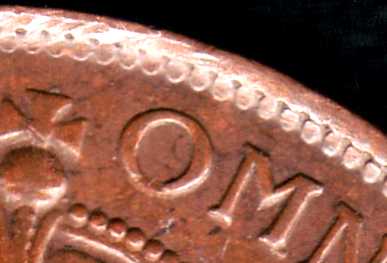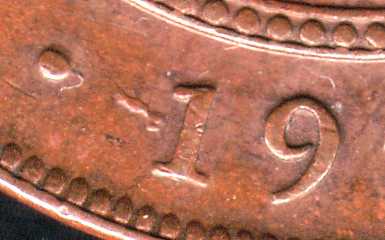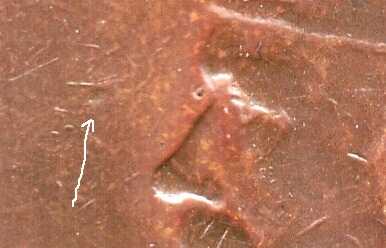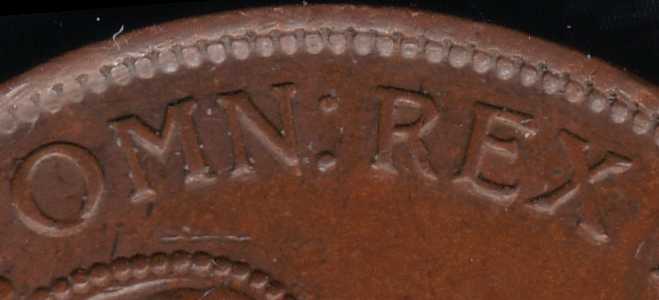
|
|
|
Designation |
|
|
|
Obverse |
|
|
|
Reverse |
|
|
|
Mint |
|
|
|
Mintage |
|
|
As is apparent from the table above, the London and Calcutta obverses were used
for this coin. Each is common.
John Dean1 listed several
varieties:
(a) Dot in front of ONE.These are all trivial and are most likely the result of die damage. The specimen shown here is of type f. The dots in types d and e can be irregular and occur at various positions so it is not always easy to distinguish them. The dot in this 'f' specimen is also irregular although that is not obvious from the picture.
(b) Dot behind crown and dot behind ear.
(c) Dot under F.D..
(d) Dot in front of nose.
(e) Dot in front of eye.
(f) Dot under first N of PENNY and dash in front of date.
 |
P29M.1A |
 |
Broken O in OMN, just like in many 1928 pennies. |
 |
Dot below first N in PENNY (Dean's variety f). Dot is quite irregular although it
looks round in this picture. |
 |
Irregular dash before date (Dean's variety f) |
 |
Dot in front of eye (Dean's variety e) |
One of the joys of studying Australian Commonwealth coinage is the seemingly
endless number of surprises one can get just by looking at the coins themselves.
When I wrote the page on the 1928 penny about a year ago, I made the following remark
concerning the broken numerals and letters that occur on that coin:
These breaks are quite common, occurring in about 20% of 1928 pennies. They may have been caused by die filling but because they are so common, it is quite likely that they were caused by a damaged working punch. Some slight support for this conjecture is lent by the observation that the lettering on both sides of the coin is heavily fishtailed, suggesting die spread in the punch and/or master tools. It is a bit of a mystery that these faults are observed only in the 1928 pennies.Well it just so happens that the obverse of the coin shown above exhibits a broken O in OMN. The mystery is now solved, albeit in an unexpected way. Clearly the faults are not confined to the 1928 issue. Of course one shouldn't read too much into this observation for the coin may have been struck with a die left over from the 1928 run. Just because the reverse die is changed, that doesn't mean the obverse has to change too.
I leave you with another observation. The pronounced fishtailing on the obverse
is only observable on the London die. In contrast, 1929 pennies struck with the
Calcutta die show no obverse fishtailing. This observation supports the conjecture
by John Sharples26 that at
least one of the penny master tools supplied to the Melbourne Mint in 1927 &
1928 was derived from the Calcutta masters.
 |
This is the obverse of the coin with the broken O in OMN. Note the pronounced fishtailing
on all the letters, most visible on the R and E. This is a London die obverse. |
 |
Another London die obverse, also from a 1929 penny. The O is unbroken and the fishtailing,
while present, is hardly noticeable. |
 |
A Calcutta obverse from another 1929 penny. No evidence of fishtailing at all suggesting
that the tooling was very fresh. |